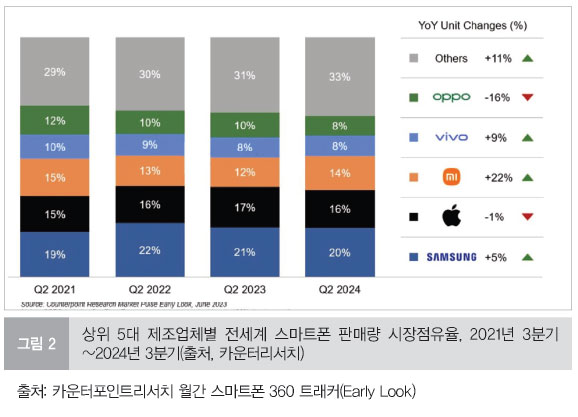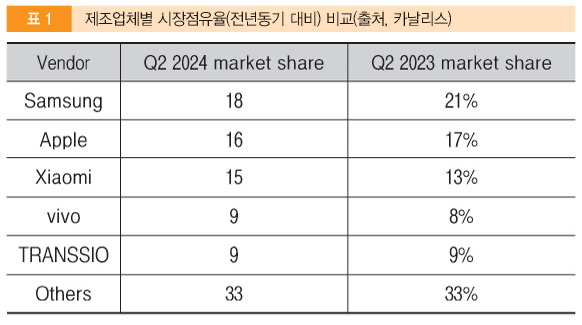Table of Contents
• Overview of the 2024 Smartphone Market
• Manufacturer and Nationality Market Shares for 2024
• Opinion


1. Overview of the 2024 Smartphone Market
In Q2 2024, the total worldwide smartphone shipments reached 289.1 million units—an 8% growth compared to the same period last year. This increase is attributed to a recovering global economy and improved consumer sentiment in various regions. Consequently, the smartphone market has seen growth for three consecutive quarters. Notably, regions such as Latin America (CALA), Europe, and the Asia-Pacific have demonstrated significant growth, and with the rising demand for premium smartphones, the Average Selling Price (ASP) for Q2 also reached an all-time high.
A key point to note is that Apple alone accounts for nearly 42% of the total smartphone market revenue, with the remaining companies sharing the rest (Samsung 16%, Xiaomi, Oppo, and Vivo combined 20%, among others).
Additionally, in terms of average selling price (ASP), Apple tops the list with a commanding $859, while Samsung records an ASP of $279—almost identical to that of Chinese brands—with Oppo and Vivo at approximately $240 and $211 respectively. These statistics clearly illustrate a bifurcation of the market into two distinct segments: the premium market, led by Apple, versus the mass-market segment dominated by Chinese manufacturers. (This is one of the main reasons why many now recognize that despite Samsung’s top spot in terms of overall shipments, its actual competitive strength is waning—evidenced by its ASP being almost indistinguishable from that of Chinese smartphones.)
Returning to the market situation, there have been signs of slowdown in some regions. For instance, India experienced seasonal stagnation due to an intense heatwave, and Apple’s sales in China decreased by 6.5%. Nonetheless, the global smartphone market continues to show a positive recovery trend, driven by increased demand for premium devices and the adoption of generative AI.
Furthermore, in 2024, the top five brands—Samsung, Apple, Xiaomi, Oppo, and Vivo—accounted for a staggering 67.9% of total shipments.
2. Manufacturer and Nationality Market Shares for 2024
2.1 Manufacturer Market Share
Rank Company Market Share (%) YoY Change (%)
1 Samsung 20.1 +5
2 Apple 16.4 -2
3 Xiaomi 14.5 +22
4 Vivo 8.8 +9
5 Oppo 8.1 -16
– Total – 67.9
• Samsung:
Samsung leads with a 20.1% market share. However, it appears that Samsung’s top ranking is largely driven by volume in the mid-to-low price segments, which has led to its image dimming. In contrast to its flagship S series or foldable phones, its mainstay product—the affordable A series—has not fared as well, due in part to quality controversies (such as the GOS incident) and shortcomings in AP chipset competitiveness. Samsung’s market share, therefore, reflects the current reality of fierce competition in the smartphone market.
• Apple:
Apple holds a 16.4% market share based on 2024 shipment volumes. Despite being the only one among the top three whose shipment volume decreased by 2 percentage points compared to last year, Apple continues to dominate in revenue thanks to its high ASP (over $800) and its powerful A-series chipsets and proprietary iOS. This solidifies its position as the premium king in the smartphone arena.
• Xiaomi:
Xiaomi ranks third with a 12.5% market share, though this represents a 4.7% decline compared to last year. While Xiaomi has shown strength in markets like India and Europe, it faces fierce competition from other Android manufacturers such as Samsung, Oppo, and Vivo, resulting in ongoing challenges across both low-end and high-end product segments.
• Vivo:
Vivo ranks fourth, with Oppo taking the fourth position in the provided data. Vivo is part of the Chinese conglomerate group that is gradually increasing its market share, leveraging growth in the Chinese market as well as strong performance in Southeast Asia and Europe. Vivo operates multiple brands, including OnePlus and Honor, and is expected to continue growing.
2.2 Nationality Market Share
Rank Nationality Market Share (%)
1 China 60 (estimated)
2 Korea 20.1
3 USA 18.9
• China:
When categorizing by the manufacturer’s nationality, Chinese companies are estimated to hold around 60% of the annual global market share. This segment includes not only well-known brands like Xiaomi, Oppo, and Vivo but also Huawei—which has managed to survive U.S. sanctions—and other notable players such as Transition, Lenovo (which owns the Motorola brand), and TCL. Most of these companies use Android as their operating system and employ Snapdragon or similar chipset technologies, directly challenging Samsung’s position. (This is evidenced by Samsung’s market share declining by over 8% compared to the 2010s.) As predicted in previous outlooks, the future market appears to be segmented between premium Apple devices and mid-to-low priced Chinese smartphones.
• Korea:
South Korea, home to Samsung’s Galaxy series, holds a 20.1% market share. Although Korean manufacturers have expanded their market share based on competitive advantages such as the premium positioning of the iPhone in the U.S. and Google Pixel’s strong software performance, Samsung’s flagship Galaxy S24 (equipped with Exynos for domestic models) and Galaxy S24 Ultra’s camera issues, along with quality control issues across the S and foldable segments, suggest that its market share may struggle in the future. (This situation aligns with predictions made by former chairman Lee Kun-hee regarding a “nutcracker” scenario gradually becoming reality.)
• USA:
The United States, home to Apple and Google, holds an 18.9% market share (with Google’s Pixel phones estimated at around 2.5%). Although this figure is almost entirely composed of Apple’s iPhone, the recent launch of the Pixel 8—featuring Google’s LLM-based Gemini AI and generative AI capabilities—could potentially capture significant market share from Samsung in North America. Thus, the market share of U.S.-based manufacturers is expected to increase gradually.
3. Opinion
The 2024 smartphone market can essentially be divided into two distinct segments: the premium segment dominated by Apple’s iPhone and the mid-to-low priced segment led by Chinese Android phones.
• Apple’s Premium Dominance:
Apple has strengthened customer loyalty through increasing demand for premium products, trade-in policies, and interest-free installment programs. Even in China, one of its key markets and revenue sources, Apple has weathered stiff competition from Chinese rivals such as Huawei, Xiaomi, Oppo, and Vivo.
• Samsung’s Growing Challenges:
Although Samsung remains the top smartphone manufacturer by shipment volume, its competitive position is weakening. The flagship S series and foldable devices, once seen as new breakthroughs, have been hampered by quality controversies (like the GOS incident), chip competitiveness issues, and difficulties in differentiating from Chinese brands in the low-to-mid priced market. These challenges reflect the broader reality that Samsung’s market share—often highlighted by media as its top ranking—may not accurately reflect its competitive strength, particularly when compared to the steadily rising capabilities of Chinese smartphones.
• The Rise of Chinese Brands:
Chinese companies like Xiaomi, Oppo, and Vivo are steadily increasing their market positions. Even excluding Huawei—which is primarily focused on the domestic market—brands like Oppo and Vivo have grown significantly in regions such as India, Southeast Asia, Eastern Europe, and beyond. Their products, which share similar performance and operating systems with Samsung’s Galaxy, are increasingly capturing market share and challenging Samsung’s traditional dominance.
Thank you for reading.
'IT & Tech 정보' 카테고리의 다른 글
| 스크린 홀딩스(다이닛폰 스크린) 개요 주요 제품 주가 현황 전망 (0) | 2025.02.17 |
|---|---|
| Global Humanoid 100 Robot Ecosystem (0) | 2025.02.17 |
| MWC2025 Special: Oppo & Vivo – Pioneers Shaping the Future of Mobile Technology (0) | 2025.02.17 |
| Xiaomi – Innovación, Estrategia Global y el Futuro en MWC2025 (0) | 2025.02.17 |
| Huawei y MWC2025 – Un Escenario para la Innovación Global (0) | 2025.02.17 |



